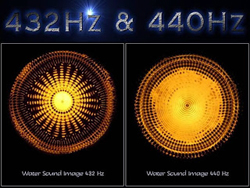When it comes to tuning an instrument, we think of the standard A note at 440 Hz as the reference standard, but it wasn’t always that way.
Prior to 1940 there were a variety of standards, although A=432 Hz (also known as “Verdi’s A”) was the one most frequently used. It wasn’t until 1940 that the US adopted A=440 as the standard, with the rest of the world following in 1953.
But why did the world change in the first place? For one thing, A=432 is supposed to be a more “natural” vibration based on the fact that it’s divisible by 3, unlike A=440 which is only divisible by 2.
A=432 is said to just feel right, and when tuning without any pitch reference, trained musicians are said to automatically tune their instruments there, and the ancient Egyptians and Greeks have also been found to have tuned their instruments at 432.
The science of Cymatics, which is the study of visible sound and vibration, is apparently on the side of A=432 as well, as you can see from the graphic on the left.
The physical nature of the two frequencies are pointed out by Dr. Leonard Horowitz in his paper Musical Cult Control, but he goes even deeper into what he thinks are the reasons why we went from A=432 to A=440.
Horowitz claims that there was a conspiracy between the Rockefeller Foundation and Nazi propaganda minister Joseph Goebbels in changing the standard because”herding the populations into greater aggression, psycho social agitation and emotional distress” was necessary to create a war mentality. Supposedly the Rockefeller Foundation had strong financial interests in weapons of war at the time, and of course the Nazis had strong interests in, well, war.
But the ultimate test is listening, so here are two versions of the same piece—one tuned to A=432 and the second at A=440. See which one you prefer.
I liked the A=432 better, but then again, I believe that the guitar should be an Eb instrument because it just feels and sounds better.
Bobby Owsinski is an author, producer, music industry veteran and technical consultant who has written numerous books covering all aspects of audio recording. For more information be sure to check out his website and blogs.





















